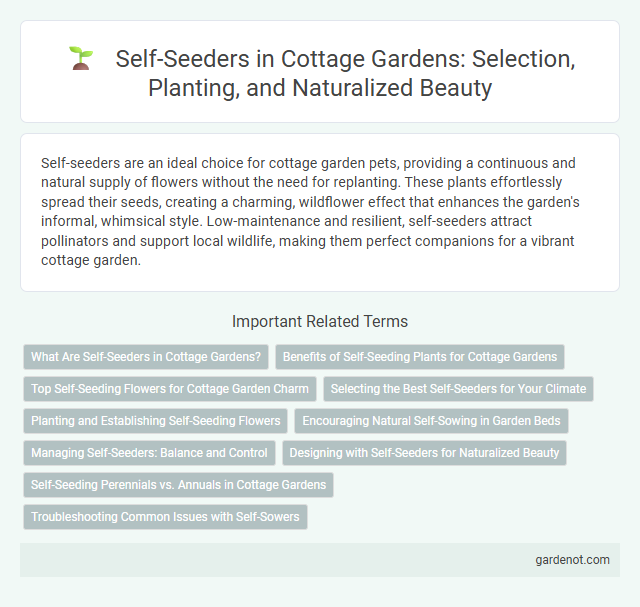Self-seeders are an ideal choice for cottage garden pets, providing a continuous and natural supply of flowers without the need for replanting. These plants effortlessly spread their seeds, creating a charming, wildflower effect that enhances the garden's informal, whimsical style. Low-maintenance and resilient, self-seeders attract pollinators and support local wildlife, making them perfect companions for a vibrant cottage garden.
What Are Self-Seeders in Cottage Gardens?
Self-seeders in cottage gardens are plants that naturally disperse and germinate their own seeds, creating effortless and organic growth each season. Common self-seeders include poppies, foxgloves, and hollyhocks, which thrive in the informal, mixed plantings typical of cottage garden design. These plants maintain garden continuity by filling gaps and spreading without human intervention, enhancing biodiversity and visual charm.
Benefits of Self-Seeding Plants for Cottage Gardens
Self-seeding plants in cottage gardens promote natural regeneration, reducing the need for replanting each season and saving time and effort for gardeners. These plants enhance biodiversity by attracting pollinators such as bees and butterflies, crucial for a healthy garden ecosystem. Their spontaneous growth patterns contribute to the charming, informal aesthetic characteristic of traditional cottage gardens.
Top Self-Seeding Flowers for Cottage Garden Charm
Top self-seeding flowers for cottage garden charm include foxgloves (Digitalis purpurea), which provide tall spikes of tubular blooms attracting pollinators. Sweet peas (Lathyrus odoratus) offer fragrant, colorful blossoms that naturally reseed season after season, enhancing garden continuity. Calendulas (Calendula officinalis) bloom profusely with bright orange and yellow flowers, thriving in cottage garden settings and spreading effortlessly.
Selecting the Best Self-Seeders for Your Climate
Choosing the best self-seeders for your specific climate ensures a thriving cottage garden with minimal maintenance. Plants like poppies, cosmos, and nigella excel in temperate zones, while zinnias and cleome are better suited for warmer, drier regions. Evaluating your local hardiness zone and soil conditions is essential to select robust self-seeders that naturally reseed year after year.
Planting and Establishing Self-Seeding Flowers
Planting and establishing self-seeding flowers in a cottage garden requires selecting species like poppies, foxgloves, and calendulas that easily drop seeds for natural propagation. Ensure the soil is well-prepared with organic matter and maintain consistent moisture to support strong seedling growth. Regularly monitor the garden to thin seedlings when necessary, promoting healthy development and preventing overcrowding.
Encouraging Natural Self-Sowing in Garden Beds
Self-seeders thrive in cottage gardens by naturally dispersing seeds in soil, promoting effortless plant propagation and diverse garden layers. Encouraging natural self-sowing involves minimal disturbance to garden beds, allowing plants like poppies, foxgloves, and columbines to reseed freely, enhancing the garden's ecological balance. Maintaining mulch-free patches and avoiding excessive weeding ensures optimal conditions for seed germination and sustained plant growth year after year.
Managing Self-Seeders: Balance and Control
Effective management of self-seeders in a cottage garden involves selectively thinning seedlings to maintain plant diversity and prevent overcrowding. Regular monitoring helps identify unwanted volunteers, ensuring they do not outcompete intentional plantings. Employing mulching and targeted weeding supports balance and control while preserving the natural charm of self-seeding species.
Designing with Self-Seeders for Naturalized Beauty
Incorporating self-seeders such as foxglove, cosmos, and nigella into a cottage garden design enhances naturalized beauty by allowing plants to freely spread and fill spaces with vibrant blooms year after year. Selecting a mix of annuals, biennials, and perennials ensures continuous succession of color and texture, promoting a dynamic, evolving landscape with minimal maintenance. Leveraging these self-sowing species creates a charming, effortlessly cultivated garden that mimics natural growth patterns and supports biodiversity.
Self-Seeding Perennials vs. Annuals in Cottage Gardens
Self-seeding perennials in cottage gardens provide long-lasting blooms year after year while gradually expanding their presence with minimal maintenance. In contrast, self-seeding annuals offer vibrant, seasonal color but require reseeding each year to maintain their display. Choosing a mix of both types enhances garden diversity, ensuring continuous flowering and a natural, effortless look.
Troubleshooting Common Issues with Self-Sowers
Self-seeders in cottage gardens can struggle due to inconsistent watering, poor soil drainage, or lack of sunlight, causing patchy or sparse growth. Identifying the specific environmental stressors, such as overly compacted soil or competition from aggressive weeds, helps restore healthy regeneration. Regularly thinning seedlings and improving soil conditions promote robust self-sowing plant populations and vibrant garden aesthetics.
Self-seeders Infographic

 gardenot.com
gardenot.com